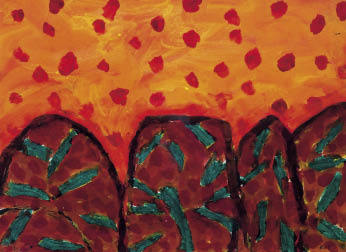William Crozier at 80
Flowers, 82 Kingsland Road, E2, until 29 May
Agnes Martin
Timothy Taylor Gallery, 15 Carlos Place, W1, until 22 May
William Crozier is Scottish born, but has lived much abroad, spending his formative years in Paris and Dublin, and later working in Spain and America, though always keeping a foothold in England. His sensibility is broadly European, perhaps influenced by the Scottish predisposition to plangent colour, and his work has an intellectual base and emotional breadth that sits easily in an international context. Step into the East End premises of Flowers and be prepared for a blaze of pure visual excitement and pleasure. The effect of this 80th birthday celebration is exhilarating.
Most of the work was done in the last three or four years, but the main ground-floor space in Shoreditch is dominated by an earlier painting entitled ‘Departure from the Island’ (1993). Larger than the rest, a glorious, zestful evocation of leaving land at sunset, with red and gold lashing the green sky and overspilling into the headlands, it highlights Crozier’s habitual and judicious use of black. Here is a splendid example of his mastery of radiant colour, with a wide expanse of brushy but depthless blue, rich vibrant yellow (over red) and jade foliage at bottom right. The shapes, too, have a combined identity that is precise and satisfying.
Crozier hones his subjects to their bare essentials: two leaf-like trees or a flower in a pot, playing off colours and patterns, such as the wonderful leopard-skin effect of ‘The Curtained Window’, or the maculate dabbing of ‘Morning, Kilcoe’ (both 2007), green on orange. A group of works on paper in watercolour and crayon, hung in the front gallery, are briskly composed around the weather and times of day — ‘Night Storm’, ‘Sunrise’, ‘The Last Light’. A recent painting of gravel pits allows Crozier the chance to orchestrate reds, greens, petrol blue and black to poignant effect. Meanwhile, a set of six new prints, done in photo-etching and carborundum, explore further his formal interests through a lovely variety of textures. All are enjoyable, but ‘Kernel III’ is the best to my eye. Crozier is famous for offering a heightened account of nature. He presents landscape reinterpreted through the colours of the heart: organic and elemental forms are paraphrased, focused and realigned, in a vivid and affirmative vision which is decidedly life-enhancing.
Very last chance to see a small but rather fine exhibition of drawings and paintings by the Abstract Expressionist Agnes Martin (1912–2004). Born in Canada, Martin spent most of her life in America, latterly withdrawing to the desert of New Mexico. Her work is minimal, consisting principally of horizontally striped canvases which resemble the mowing patterns on a lawn or meadow. This imagery is often compared to music, perhaps because her stripes look a little like sheet music, though it seems that she herself preferred silence. She said: ‘My interest is in experience that is wordless and silent, and in the fact that this experience can be expressed for me in art which is also wordless and silent.’ Not much music there, unless it be John Cage’s silence.
The exhibition at Timothy Taylor Gallery consists of just 11 items, dating from 1957 to 2001, and ranging from small watercolour studies to substantial oil paintings. An early work, ‘Drift of Summer’, is composed of four near-circles on a rhombus in yellow. Another is made up of serried ranks of pale grey triangles (not unlike an early Bridget Riley, an artist this gallery also shows). After that, Martin adopted a grid pattern based on the rectangle rather than the square, to provide a framework and discipline within which to explore her formal and thematic interests. The other works in this show are the distinctively banded compositions, pale as bleached bed linen, the stripes edged by pencil lines. These paintings are so subtle and harmonious they seem to be fading away and might vanish if you don’t pay attention. Invested with a deep knowledge of Taoism and Zen Buddhism, they are about the endlessly frustrated search for perfection and serenity.
I am writing about an exhibition that is on the point of closing because Agnes Martin is an artist worth bringing to your attention, and because there’s another show of her work that you might wish to see if you miss the London one. At the time of going to press I hadn’t viewed the exhibition at Kettle’s Yard in Cambridge (which runs until 11 July) but it includes a group of ten late canvases painted between 1991 and 2002 which constitute a considerable statement about, if not a summation of, her aims and intentions. Kettle’s Yard is always worth a visit for the treasures from Jim Ede’s collection on display in the house, but with the Agnes Martin show in the gallery it is a doubly desirable destination and a welcome opportunity for serious contemplation.






Comments